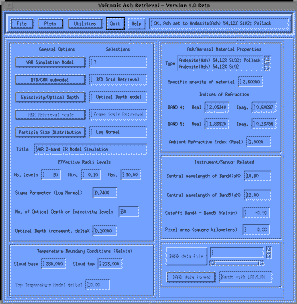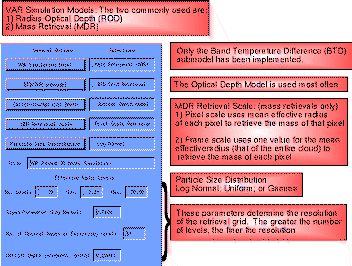Introduction to Radiannet: Volcanic Cloud Retrieval Program
Radiannet is a two-band radiation simulation model. Retrievals of the physical properties of volcanic clouds are processed by adjusting the optical and physical parameters in the radiative transfer models to best fit the observed radiances.
In the current program, AVHRR and GOES Band 4 and Band 5, and GMS-5 Band 1 and
Band 2 brightness temperatures can be simulated. The assumptions for using this program are:
- Spherical Aerosol Particles
- Homogeneous Parallel Cloud Layer Parallel to a Homogenous Underlying Surface
- Single Type of Aerosol in the Cloud: ice, water, ash(andesite, basalt), or H2SO4
- Atmosphere above and below the volcanic cloud are clear windows, with high transmission.
 Click on the image to the left to look at a larger version of the IDL widget interface.
Click on the image to the left to look at a larger version of the IDL widget interface.
Radiannet is composed of many different FORTRAN and IDL subroutines.
An IDL widget interface is used to make entering the input parameters easy. The IDL code spawns FORTRAN subroutines,
which does the radiative transfer calculations. The results of the calculations are
transfered back to IDL and output plots are produced.
Background Information
For information on the basic theory behind the Radiannet Program see
"Retrieval of sizes and total masses of particles in volcanic clouds using
AVHRR bands 4 and 5" by Shiming Wen and William I. Rose in Journal of
Geophysical Research, VOL. 99, NO. D3, Pages 5421-5431, March 20, 1994.
This research was presented at the AGU 1993 Fall meeting, and is
available online.
General Options Panel
 The majority of the volcanic ash retrieval options are found on the
General Options panel. A summary of each of the options is shown to the left.
Click on the image to view a larger version.
The majority of the volcanic ash retrieval options are found on the
General Options panel. A summary of each of the options is shown to the left.
Click on the image to view a larger version.
The general processing order is:
- Select the Ash/Aerosol Material Properties
- Select the Radius-Optical Depth Model (ROD)
- Take an initial estimate of the proper field and button settings (The
defaults are a good start). The main factors that change from scene to
scence are the Ts and Tc boundary conditions.
- Save the model case
- Run the case file
- Plot the ROD results, and overlay the AVHRR pixel values
- Adjust the field parameters if necessay. The most common
adjustment it to the Ts boundary condition.
- Repeat steps 4, 5, and 6 if needed.
- Select the Mass Retrieval Model
- Fill in additional fields
- Data file name
- Pixel Area
- Save the case file, and run it.
The Mass Retrieval program produces two output files.
- a *.mdr file which contains mass, optical depth and effective radius
values for each pixel. It can be converted and read into Terascan to produce
maps of each of these cloud properties.
- A *.tex file which contains the overall results of the retrieval.
This page maintained by Dave Schneider (djschnei@mt
u.edu)
 Click on the image to the left to look at a larger version of the IDL widget interface.
Click on the image to the left to look at a larger version of the IDL widget interface. Click on the image to the left to look at a larger version of the IDL widget interface.
Click on the image to the left to look at a larger version of the IDL widget interface. The majority of the volcanic ash retrieval options are found on the
General Options panel. A summary of each of the options is shown to the left.
Click on the image to view a larger version.
The majority of the volcanic ash retrieval options are found on the
General Options panel. A summary of each of the options is shown to the left.
Click on the image to view a larger version.